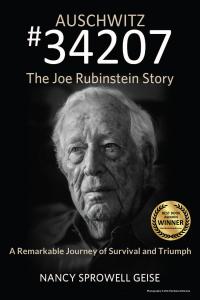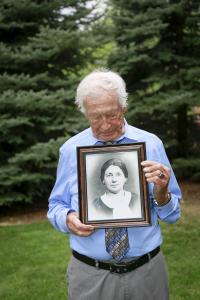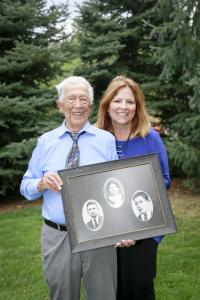It’s been nearly 80 years since Joe Rubinstein was taken from the Radom, Poland, ghetto. He never again saw his family. His search to see their faces continues.
— Joe Rubinstein
CASTLE ROCK, COLORADO, UNITED STATES, April 1, 2021 /EINPresswire.com/ — “I would give my life for one photo of my family.” That is what Holocaust survivor, Joe Rubinstein, told author Nancy Sprowell Geise of the book about his life: Auschwitz #34207 The Joe Rubinstein Story.
Geise believed that because Joe’s family lived in Radom, Poland, for generations, there had to be photos of them somewhere.
While writing the book, researchers around the world searched for photos but to no avail. Six months after the book was published in 2015, researcher Susan Weinberg contacted Geise to tell her that she had found three photos of Joe’s family: Joe’s mother Reska; his older brother Dawid; and Joe’s identical twin Chaim. Geise said she had never seen human emotion as powerful as the day Joe held those photos of his beloved family, faces he had not seen in over 70 years.
At the time, Joe said through his tears, “This is the greatest gift of my life.” Missing, however, were photos of two more of Joe’s siblings…his younger brother Abram (born 8/26/1923) and his sister Laja (born 3/15/1926). Geise said that every time she speaks to Joe, he asks, “Have you found photos of Abe and Laja yet?” Geise said it would mean the world to him to see their photos.
Photos of Joe’s mom and his two brothers were discovered on the papers that the Germans filled out when Joe’s family was forced into the ghetto. Geise was told that the papers had long ago been destroyed in a fire; however, Weinberg informed her that not all of the documents were destroyed. Geise said, “We all have so many photos we don’t know what to do with them, and here is this sweet man saying that he would give his life for just one photo. It’s a lesson for us all—cherish what we have.”
Twenty-year-old Icek Rubinsztejn (Joe Rubinstein) was taken from the Radom ghetto by German soldiers on a frigid morning shortly before dawn. Wearing only shorts and a t-shirt, Joe was forced onto an open-air truck. With no protection from the cold, he huddled with strangers. Hours later, several others around him were dead from exposure. From there, things got worse for young Joe.
Joe arrived by train at Auschwitz/Birkenau on April 30, 1942. Joe would never again see anyone he knew or loved, including his entire family: his widowed mother; his younger sister; and his three brothers (his identical twin among them), were all believed murdered at the Treblinka Death Camp, along with over 30,000 people from the Radom ghettos.
Joe Rubinstein still cannot speak of his lost family without weeping. Until Rubinstein shared his story with author Nancy Sprowell Geise, he had not told anyone of his experiences, being in captivity for nearly five years during WWII, including over two years at Auschwitz/Birkenau concentration camp. “Although he lost nearly everything a person can lose,” Geise said, “Joe went on to live a joy-filled life. Barefooted when he was seized and put on that truck, Joe became one of New York’s leading shoe designers. His life of never giving in to despair is an example for us all.”
Rubinstein celebrated his 100th birthday last fall. The mayor of Fort Collins, Colorado, where Joe now resides, proclaimed the day: Joe Rubinstein Day.
Geise said, “Joe never told anyone his story because he did not believe anything good could come from doing so. Now, Joe hears from people around the world writing to tell him about the impact his story of hope is having on their lives.” Geise has been asked to share Joe’s story around the world including the U.S. Library of Congress in Washington, D.C.; in Joe’s hometown of Radom, Poland; and at the Auschwitz-Birkenau Memorial and Museum in Oświęcim, Poland. http://auschwitz.org/en/
Geise hopes that one day soon, Joe’s journey will include Joe being able to find the photos of a brother and sister that he still loves with all his heart.
If anyone has information about photos of Joe’s family, or for more information about Holocaust survivor Joe Rubinstein’s remarkable life, see: http://www.nancygeise.com
Auschwitz #34207 The Joe Rubinstein Story is available at the on Amazon: https://www.amazon.com/gp/product/B00VRZ40B2
Auschwitz #34207 The Joe Rubinstein Story is an award-winning audiobook: https://www.amazon.com/Auschwitz-34207-audiobook/dp/B01BO4YZXS
Donna Mazzitelli
Merry Dissonance Press
+1 925-683-7057
https://merrydissonancepress.com
Visit us on social media:
Facebook
Twitter
LinkedIn
![]()






















